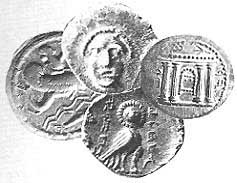Editor, H. S. (2002;2002). BAR 04:01 (March 1978). Biblical Archaeology Society.
The Holy Land in Coins
By Yaakov Meshorer

Ancient coins from the Holy Land.
What archaeologists find is important. But what they don't find can be just as important–such as their failure to find coins anywhere in the world before the end of the 7th century B.C. In the Holy Land, coins are not found until about 100 years later.
This total absence of coins–despite extensive excavations–is an important datum in itself. It means that Biblical references to specific coins during the First Temple Period (c. 960 B.C.–586 B.C.) are anachronistic. The Biblical historian writing at a later time, when coins were in use, assumed–incorrectly–that they were in use at an earlier period.
There are several examples of this kind of anachronism in the Bible. The author of the first book of Chronicles (writing during the Persian Period (539–333 B.C., the beginning of the Second Temple period) anachronistically assumed that coins were in use in the earlier period he was writing about; the author tells us of contributions of darics to assist in building Solomon's Temple (see 1 Chronicles 29:7 ).
Before the introduction of coinage, commerce and exchange were carried on in the Holy Land by weighing precious metals–gold and silver–with weights and scales. This system was cumbersome, and the accuracy of the weights was questionable. It was also difficult for the ordinary merchant to judge the purity of the metal. With the development of international commerce, a better and simpler means of exchange was inevitable.
In Biblical sources written before 586 B.C., payment is made either in ingots of precious metals or, on occasion, jewelry. Most of the ingots mentioned in the Bible are gold, such as the gold ingots hidden by Achan which brought the Israelite defeat at Ai (see Joshua 7:21 ). (The references to shekels in this passage are to a unit of weight, as is clear from the passage itself; only much later did the shekel become a coin.)
Biblical descriptions of jewelry–earrings and bracelets–often include exact weights; the jewelry was deliberately molded into certain standard weights, so that it could be used as a means of exchange. (A)1 In Genesis 24:22 Abraham's servant gives Rebecca "a golden earring of half a shekel weight and two bracelets for her hands of ten shekels weight of gold."
1Letters in parentheses refer to photographs seen here.
next page >
page 1:8
 
|